
Metro President Lynn Peterson and Portland Mayor Ted Wheeler have found a politically convenient way out of the predicament posed by the very unpopular I-5 Rose Quarter Project: the Albina Vision plan. Drowning in a sea of controversy around the idea of expanding a freeway through our central city, both leaders have made this plan central to their position on the project.
“One of the biggest opportunities in our region is the Albina Vision plan.”
— Lynn Peterson, Metro President
These key leaders support the project, much to the chagrin of the broad base of opposition that emerged in recent months. The $500 million project seeks to redesign surface streets in the Rose Quarter and add new lanes and shoulders to I-5 between I-84 and the Fremont Bridge
Wheeler and Peterson see it as a relatively minor (technically speaking), necessary project and they trust the Oregon Department of Transportation (ODOT) — an agency that claims adding lanes and shoulders to I-5 will reduce crashes and decrease congestion, while having no major impact on air quality or greenhouse gas emissions — to see it through.
As the community’s distrust and doubts about ODOT rose during a recent comment period on the project, so did pressure on Peterson and Wheeler. In the past month, both leaders have tried to clarify where they stand.
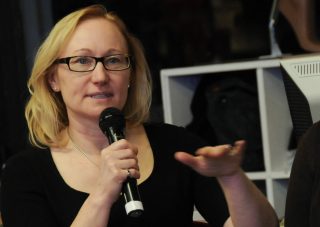
(Photo: J. Maus/BikePortland)
Peterson spoke about the project at her recent State of the Region address and in an interview on KATU-TV (Portland’s ABC affiliate). She and Wheeler also wrote a joint letter to Oregon Transportation Commissioner Chair Tammy Baney on April 5th that outlined their views and concerns.
In her recent public appearances, Petersen has sent mixed signals. On one hand she said she wants to “keep moving on” with the project; but she also acknowledged that the Oregon Department of Transportation (ODOT) has not adequately accounted for the project’s environmental impacts. (Keep in mind that Metro, the agency Peterson oversees, has accused ODOT of willful obfuscation about the project’s impacts and has called for a more thorough environmental review.)
Then there’s Peterson’s full embrace of the Albina Vision plan, which she sees as inextricably linked to the freeway expansion.
When it comes to transportation, Peterson is expected to bring a more progressive and reform-minded view to the table than her predecessor (a former mayor of suburban Hillsboro). Activists are watching her closely as she steers the 2020 Transportation Investment Bond toward the ballot. That’s why local transportation insiders watched her State of the Region speech on April 19th so closely.
“For decades we’ve questioned the ways we approached growth and change… we pioneered light rail instead of building another freeway.”
— Lynn Peterson
In that speech, Peterson touted Portland’s “visionary” legacy. “For decades we’ve questioned the ways we approached growth and change,” she said. “When we needed to figure out how to move more people from the eastside into downtown Portland, we pioneered light rail instead of building another freeway.”
Peterson, who told the crowd that she drove to the event, bemoaned congestion and the unsafe road conditions caused by too much driving. She talked about the “rebirth of downtowns” with safe places to bike and the need to, “create corridors that connect and rebuild our communities into healthy, walkable communities that support small businesses.”
Advertisement
When Peterson directly addressed the I-5 Rose Quarter project she said the freeway is, “Oregon’s connection to the world,” and businesses all over the state rely on it to get their goods to market. “Our legislature has stepped up to support improvements to our freeway system,” she said. “But we have to be smart about how that system interacts with our own communities.”
Then she made a notable pivot: “That’s why one of the biggest opportunities in our region is the Albina Vision plan.”
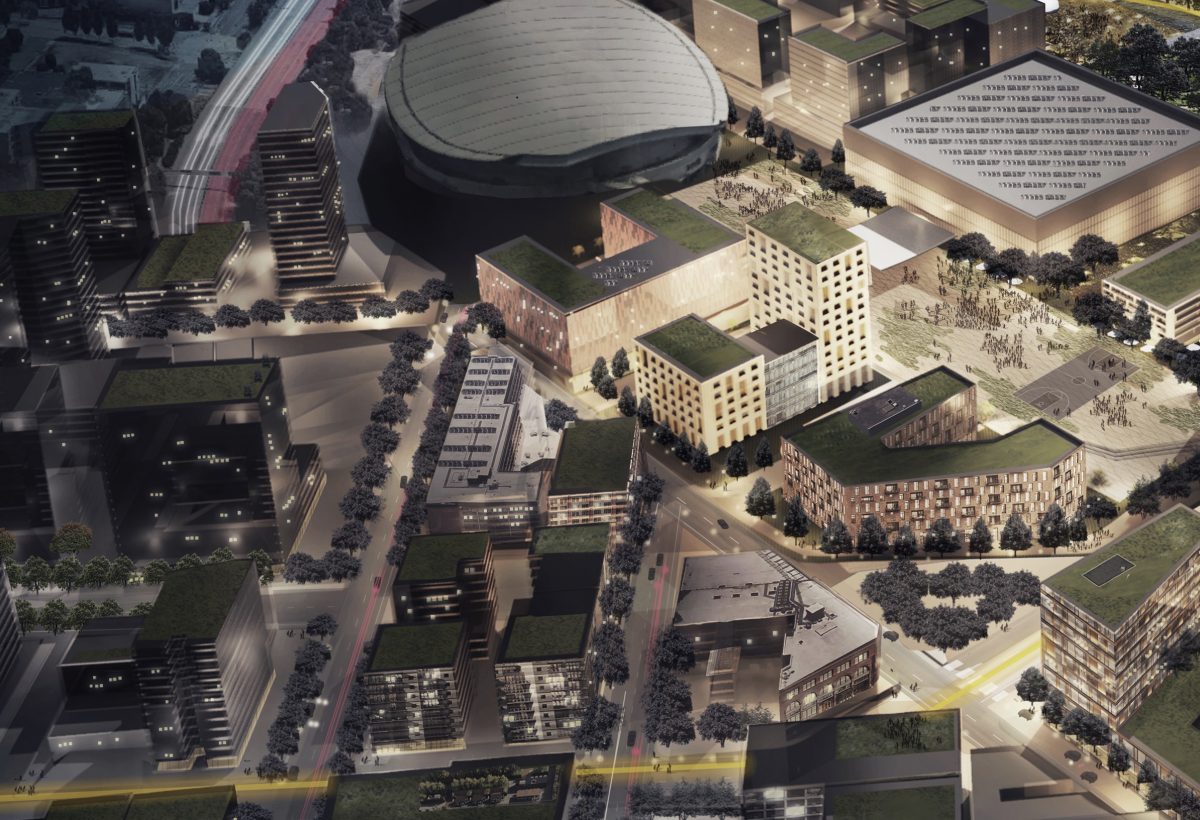
(Graphic: Hennebery Eddy Architects)
The Albina Vision plan is in its infancy and at this point is nothing more than a few conceptual renderings, but that hasn’t stopped Peterson and Wheeler from grabbing hold of it.
In a Q & A portion of the State of the Region event, Peterson was asked by former Portland mayoral candidate Sarah Iannarone if she could envision a revitalized Albina neighborhood without the I-5 project. “In what ways can Metro leverage its regional coordinating function to help us see a bold future in Lower Albina that doesn’t include freeway expansion, especially when you think about our climate action goals and goals to reduce greenhouse gas emissions in a very short time frame?” Iannarone asked.
Peterson replied by touting the project and saying she supports the I-5 project for two main reasons: The freeway lids and a need to alleviate a “chokepoint.”
The lids, “Will be able to allow for that connective tissue of urban-ness so that you never feel like your’e walking across a freeway,” Peterson said. “[The lids] aren’t going to happen if we’re not also doing the other part of the project.” As for the “other part,” Peterson feels like the addition of 3.2 miles of new lanes and shoulders (what economist Joe Cortright calls “hidden mega-freeway”), “Is actually a small tweak to a freeway system.”
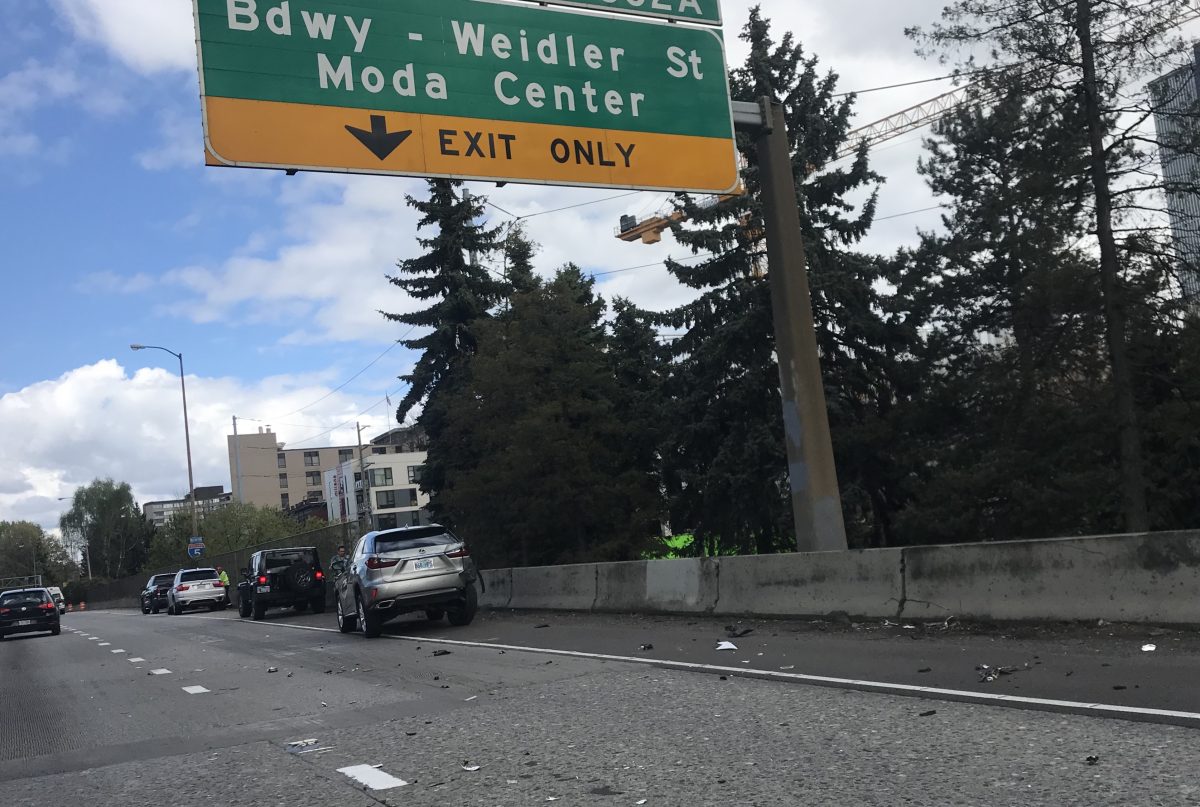
(Photo: J. Maus/BikePortland)
Peterson said the new lanes on I-5 are necessary to prevent “little fender-benders” that cause traffic back-ups. “If we’re going to put predictability back into the system we have to do some small tweaks. Some of these small tweaks are pretty dang expensive because they’re in the middle of the urban area. But they’re worth it. They’re worth it for the long run and I think we need to keep moving on.”
Peterson echoed this stance a few days later in an interview on KATU’s Your Voice, Your Vote program where she once again said her main justification for the I-5 project was that it would spur the Albina Vision plan.
“I think it’s refreshing that leaders are listening… We applaud their willingness to speak up.”
— Rukaiyah Adams, Albina Vision
“The more important aspect of the project though [beyond addressing congestion], is that it will allow for the Albina Vision to be realized,” Peterson offered. And again she mentioned that she sees the freeway lids as the lynchpin to that vision. “How do we use that [freeway lids] to reinvigorate, economically, physically, to spur all this development in the Rose Quarter?”
As we reported on March 29th, according to Albina Vision leader Rukaiyah Adams, the main problem with ODOT’s current lid design is they’re slated to be nothing more than empty spaces. “There is no need for small, unused spaces on top of l-5,” Adams said in a letter to ODOT and the Federal Highway Administration.
Compare that to the April 5th letter from Mayor Wheeler and President Peterson: “ODOT, through the freeway caps, has an opportunity to provide open space in an area that sorely needs more public space.”
Asked by KATU if it’s time to go back and start the project over, Peterson said she wants ODOT to do more analysis of community impacts and that we need to, “Get to an outcome where we have a design that the community designed, not that ODOT designed.”
That “community” will include Rukaiyah Adams, leader of Albina Vision Trust. I asked her what she thought of Peterson’s recent comments and the embrace of her project by Metro’s President and Portland’s Mayor.
“I think it’s refreshing that leaders are listening,” she shared with BikePortland. “What started out as a discussion about an interstate improvement project has expanded into a thoughtful exchange of ideas about how a modern transportation system can help us realize a better community.”
“And, in this case,” Adams continued, “that discussion is squarely reckoning with the destruction of the historic African-American community in Portland. If having civic leaders talk about that openly is jarring, it should be. It was intentional and staggering in its audacity. So too must be the way that we talk about it and remediate it.”
Wheeler’s budget released today includes $70,000 to further develop the Albina Vision. Peterson says she’s setting up a meeting with Adams, OTC Chair Tammy Baney, ODOT, and the City of Portland. I wish them well. It’ll take plenty of audacity to find a way forward that the community is comfortable with.
— Jonathan Maus: (503) 706-8804, @jonathan_maus on Twitter and jonathan@bikeportland.org
Never miss a story. Sign-up for the daily BP Headlines email.
BikePortland needs your support.


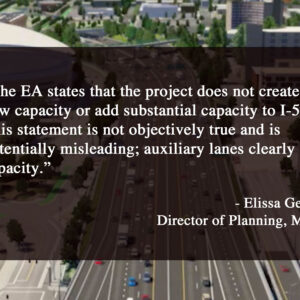
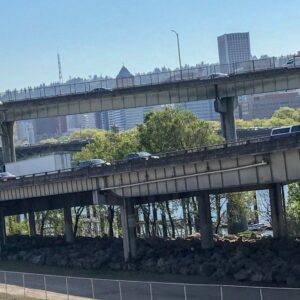
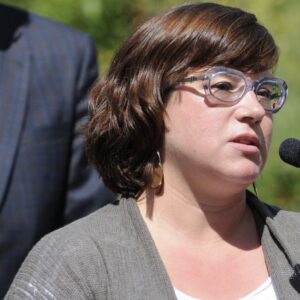
Thanks for reading.
BikePortland has served this community with independent community journalism since 2005. We rely on subscriptions from readers like you to survive. Your financial support is vital in keeping this valuable resource alive and well.
Please subscribe today to strengthen and expand our work.
That’s right. In fact, my understanding is that the planned lids will be structurally incapable of supporting buildings on top of them, or do I misrecall? If I’m right about that, what a con!
You are correct, the lids will serve no functional purpose other than providing staging and detour space during construction which is expected to take years.
Oh Yes, the magical lids. But to get to them on our bikes we will have to cycle up the proposed 10% grade that will replace the current bike connection on Flint. Not sure this is part of Albina Vision.
Lucky for Us, Wheelers political capital and influence has shrunk to a point where he is about halfway between the Unipiper and Timber Joey.
I’m pretty sure that both of those beloved local celebrities are way ahead of Wheeler.
Both the Unipiper and Timber Joey have waaaay more clout than Wheeler, he has barely more than the Belmont goats.
I really don’t understand Wheeler’s support for this project. What constituency of his is interested in this? The (short term) beneficiaries are the suburban car commuters/freight companies at the primary expense of neighboring residents.
At first I thought his support was in order to build up his resume for an eventual run for Governor (and this freeway expansion plays much better statewide than it does in the city he’s the mayor of) but he seems so completely checked out and exasperated at this point that I can’t imagine even he’s thinking of running for higher office.
” What constituency of his is interested in this?”
I’m guessing people that drive I-5 frequently.
Since 20% of the traffic on I-5 thereabouts is WA residents coming to OR to avoid paying their sales tax, perhaps Wheeler’s constituency on this are retailers. If there is a sense that he tried to make it easier for their customers to show up, they may be more inclined to support his future campaigns.
I’m really reaching here in an attempt to explain something that makes no sense. I guess it shows. Maybe he’s just not very bright and buys the junk that ODOT is selling.
People in SW Portland that identify more with Washington County/Lake Oswego, think that Portland is scary/weird, and want to drive through it as quickly as then can when they take trips to Seattle, The Gorge, Mt. Hood, etc. So, most of SW Portland.
Not true! Many people who live in SW Portland value our connection to *downtown* Portland and don’t want to see I-5 expanded in the Rose Quarter. We want better cycling connections to downtown. Please don’t tar us all with the same brush. Thanks.
I grew up in SW Portland, so I know it well. You and I are in the minority. Most in SW like it because it is isolated from the other quadrants. Cycling rates in SW are extremely low.
I’ve been trying to parse out the cycling numbers from this neighborhood breakdown lately. I’m not entirely confident the source of this data accurately represents the neighborhood but it’s the only neighborhood breakdown I’ve been able to find. For SW neighborhoods the average commute by bike percent is 5% according to this table. Which is a little below the Portland average but still pretty good for the nation. My favorite take away from this table is 29 neighborhoods in Portland have bike commute rates higher than the Portland average. Which contain 60% of all bike commuters but only 24% of the population. 4 of those neighborhoods are in SW.
https://www.pdxmonthly.com/articles/2019/3/26/portland-neighborhoods-by-the-numbers-2019-the-city
Gotta build it to get the pork.
It’s an interesting point. Considering the “developer community” is historically such an important “constituency” (i.e. donor class), you’d think Ted would actually be pushing hard for a real lid that is buildable.
I think it is also ironic that in the same “State of Region Speech” where she outlined her support for the I5 freeway expansion despite the objections of Portland Public Schools, Peterson broke the news that after a 5 year closure Metro had decided not to refurbish the Zoo Train line to Washington Park. So her message is pretty much, ” heck with the kids and let those truckers roll .”
Everybody give Rukiayah Adams a big standing round of ovation for holding this space for our community to get to the heart of the matters. SHERO!!!! Very well written article and nice art work. I ❤️❤️❤️❤️ Bikeportland!!!
$500,000,000+ could: increase highway capacity for about a mile, adding to driving, pollution and reducing fender-benders or…
Complete pretty much ALL of the projects the whole 20-year CITY-WIDE Bike Plan, or…
Be focused on traffic safety projects to save lives, and save scores of them.
To say something is “worth it” is saying it’s worth more than the other things.
Though better than Hughes, Peterson’s a traffic engineer by training and was a highway design and construction engineer in Wisconsin.
Feds won’t contribute much to a citywide bike plan, you probably already know. This money is earmarked for freeway expansion as I understand it. Use it or lose it. You and I might rather lose it, but that would be political suicide for Wheeler and them.
I agree, JaredO. The other things we could be doing with the half-billion$ are the main reason I oppose this project.
Yes, and Albina Vision is getting a paltry $70K. Ironic, right?
As I’ve explained before, for several years I commuted by bike from SE Portland to downtown Vancouver. I typically used some combination of Interstate or Vancouver/Williams/MLK (at the north end). When there was congestion or a crash on I-5, motorists diverted to my bike route, making it really uncomfortable and unsafe as motorists sought to make up time lost due to the crash/congestion.
Solving a specific bottleneck on I-5 and creating a place where disabled vehicles can get out of the travel lane will reduce the diversion and unsafe conditions on the routes bicyclists use.
I think the Rose Quarter project, and specific provisions for bicyclists and pedestrians, can be made better than currently planned, but I don’t support the status quo. I’m ok with some added lanes and shoulders.
I agree with this. It’s a bad design but they’re proposing to replace it with another bad design. If we’re going to fix it we should do it right. Which means caps that can actually support rebuilding that neighborhood. Directing pollution away from neighborhoods and schools. Pedestrian and bicycle infrastructure that isn’t absurd (10% grade). Right now they’re just making promises to fix some of these things in design but that’s hardly enough of a commitment or clear enough direction to make this project palatable to anyone that actually lives in the area.
I think they’d get a lot more support if they incorporated these ideas. And since they can’t find the money to repair their much more dangerous highways like 82nd or Powell maybe this project shouldn’t proceed if they can’t find the money to do it right.
While this is a valid concern, it seems less important when compared with the pedestrians/cyclists getting killed in other parts of the city. As a society, we should be dumping money into outer Division, outer Powell, Marine Drive, etc to add bike and pedestrian facilities, medians, speed cameras, etc. Saving long-distance commuters time on I-5 is not going to make Portland a better place to live.
I think reducing long-distance commuting is a really high priority and have long advocated for higher gas taxes to achieve overall reductions in driving. But “congestion is your friend” has not reduced commuting, rather it has pushed motorists from freeways to arterials, from arterials to collectors, from collectors to local streets and greenways.
I also regularly support more enforcement. Lots of automatic speed camera and red light cameras. Lots higher fines. Even swiping a proof of insurance card before pumping gas. Random sobriety stops. The vehicular killings must stop.
Refusing to make any physical infrastructure changes because it might make it more convenient for users of motor vehicles is not helping.
I really do see the point your making an understand how you’re approaching this project. And honestly, if people like you were advocating this proposal I’d be more inclined to (if not outright support) be agnostic about it. Specifically, since you’re suggesting that it’s critical to pare up infrastructure spending with mechanisms to manage demand (e.g. a steep gas tax) it’s much more thoughtful than what we’re getting from ODOT.
The problem is that we aren’t getting any demand management measures here. So the half billion we spend to marginally improve commuting times (in the short term) will make farther afield exurban development more attractive. As a result, eventually we’ll end up back at the same place. With the freeway over capacity and anxious commuters being pushed to arterials, collectors, local streets and greenways.
More people aren’t driving on our greenways because of the I5 bottleneck. Improving infrastructure to address people cutting through our neighborhoods would be expanding our arterials or building another freeway. So it’s great and all to say we should address congestion to reduce cut through traffic but the reality of that is a forgone conclusion we’re not going to do that. So where does that leave us? At most this expansion will slightly reduce traffic on Interstate, Vancouver, and MLK but will we even notice it by the time it’s done? ODOT has already admitted they don’t think this will reduce congestion but will just increase throughput and reduce fender benders. Wouldn’t that same congestion drive people back to our arterials and neighborhoods?
Also with induced demand being largely accepted as reality how can you say congestion has not reduced commuting? There are people not commuting to work right now because of traffic. If congestion were better they would drive.
Continuing to accommodate motorists at every turn and making driving easier at the detriment to other modes is not helping either. So where does that leave us? Making it more convenient to drive causes more people to drive it doesn’t seem to have much effect on congestion.
Again I still think this idea could work but more as a rejuvenate and fix the neighborhood project with a bonus bottleneck fix for the interstate.
It’s a complex issue. If you reduce a bottleneck in one spot, traffic counts increase, and it moves to another spot. If the CRC had been built as planned a few years back, we would be seeing major diversion of southbound traffic. It probably would help relieve northbound diversions, by eliminating the bottleneck at the state line.
The point is, if we want to make greenways safer, we need to make greenways safer. Spending billions to add freeway capacity is just going to move bottlenecks around. It’s a game of whack-a-mole.
““congestion…has not reduced commuting, rather it has pushed motorists from freeways to arterials, from arterials to collectors, from collectors to local streets and greenways.”
The bulk of evidence suggests that increases “congestion” reduces driving overall:
https://en.wikipedia.org/wiki/Induced_demand#Reduced_demand_(the_inverse_effect)
The answer to too many freeways…and bad freeways…is more freeways…
Only in the Political world where donors are promising wads of cash for piles of concrete.
I hope Wheeler and Peterson’s support for the Rose Quarter project comes with a demand to develop the lids in a much more extensive, continuous cap that can be built upon and does not have breaks into it and is extended far enough north to replace the Flint connection. The project also need to remove the on/off ramps at Braoadway; ODOT’s proposed treatment for Broadway/Vancouver/Williams is such bad urban design!
“Ah yes — the lids. Great expanses of heat-reflecting concrete.” Spoken with such authority, John, but where is your proof? Here is mine: Go to Google maps and look at the lids over I-90 on Mercer Island near Seattle. Nearly solid green of plants. The are “beautiful green spaces like in the renderings.” Go look. The sour version is in your head. If Seattle can do it right (actually WSDOT) then so can Portland (ODOT).
Teddy,
I have quite a bit of experience in this area. I have worked as a landscape architect in British Columbia and in Portland, I have designed landscape projects on structures, and I have worked as a consultant for PBOT, ODOT, PP&R, and most other local public agencies. There are a couple of key differences between the lids ODOT is proposing and the covers in Seattle:
1. The covers in Seattle are designed to incorporate transit and development projects from the start. They can carry large soil loads. These are small, disconnected lids. They are small to avoid having to deal with emissions. They are being designed and built as low-cost staging areas, then being retrofit as “amenities”. Even if they are green, from an urban design standpoint they are useless. They are isolated by large, fast, multi-lane lanes, disconnected from any commercial, residential or civic activator, and above a freeway. because of their small size, the sound and smell of the freeway will make these unusable. They are completely different than the projects in Seattle in scale and utility.
2. Seattle is a maritime climate, Portland is a Mediterranean climate. Our summers are a lot hotter and drier. Placing soil on structure disconnects it from the earth meaning plants that are adapted to drought cannot rely on deep-rooting strategies or low levels of soil moisture to sustain them through drought. Soil on structures dries out quickly and completely without irrigation. There is no precedent for ODOT paying for irrigation or successfully maintaining any landscape. PBOT has officially changed its policy to not maintain any landscape under its jurisdiction, even those it has built; they will not be taking on the care or this openspace. PP&R is strapped for maintenance dollars already. The irrigation bill alone for this area will be extravagant (all bureaus pay standard City rate for irrigation, no exceptions). Add to that that these are likely to be seldom used due to their disconnected nature and loud, unpleasant character and you have a prescription for a derelict openspace; a camper’s paradise. PP&R will do everythign it can to avoid inheriting the on-going maintenance of this expensive, unwanted, undesirable openspace.
As a landscape architect and urban designer, I am a huge proponent of more green spaces in the City, and I know the value of a well-designed park. These lids are not that. This is a greenwashing effort; a media trick to garner support for a wider freeway, and wider , faster surface streets that will behave more like freeway on- and off-ramps than City streets. If ODOT were willing to go back to the drawing board and design an actual freeway cover, like those in Seattle, the process would start from the top and identify what area needs to have better connections, meaningful openspace, healthier commerce, safer travel for all modes, etc. The lids would get bigger, be a different shape and probably support some new buildings. The on- and off-ramps to Broadway would need to seriously be considered being removed, or at least re-worked to have a safer, urban geometry. And on and on. Please don’t be fooled be the colorful renderings that ODOT is showing the public., they are deeply misleading.
You get the lids you deserve, or the lids for which you work. But John’s vision is not ordained. Look at WSDOT’s newest animal crossing lid on I-90 at Snoqualmie Pass: no ventilation required and fully green.
I missed this comment the first time around. It seems really sensible in light of some experiences that I’ve had. Since we’re still chewing on these issues three years later, could we hear more from maxD?
For $500 million, the public deserves a lot more than a “tweak”. Especially a tweak that will ultimately make the transportation situation worse. The traffic problems in Portland need a change in direction: faster, more convenient public transport, and disincentives for driving. Let’s use this $500 million to get started on a different path.
That cartoon by Cloe Ashton is a classic!